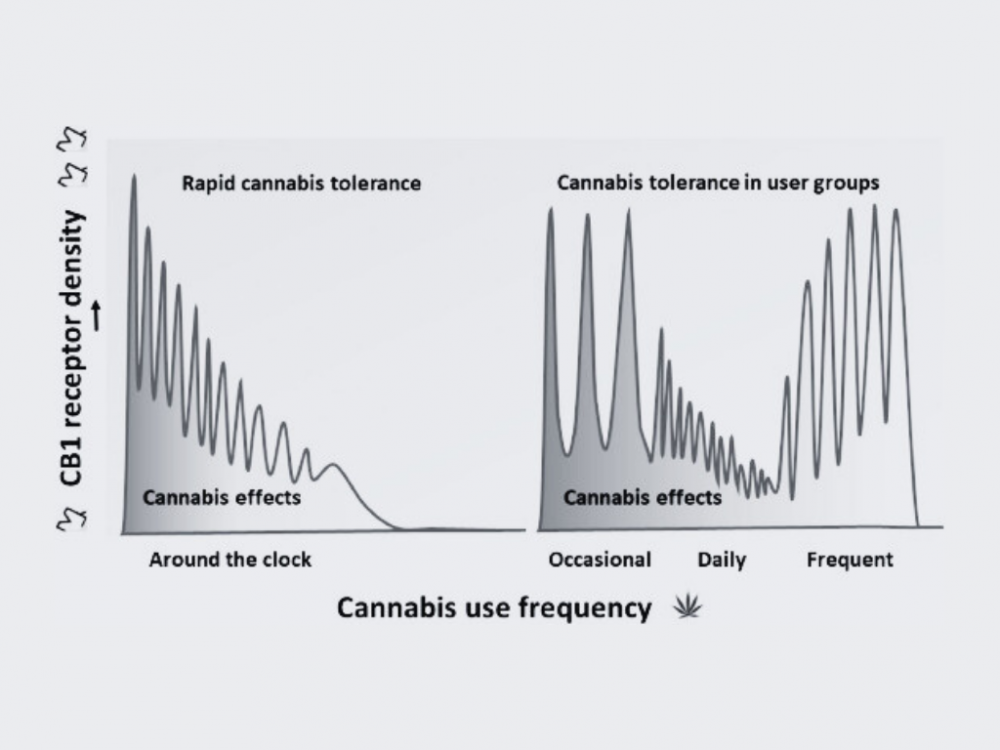
Exploring Cannabis Use Frequency and Tolerance: Navigating Continuous, Occasional, Daily, and Frequent Use
Cannabis, a complex plant brimming with various chemical compounds, has a rich history of use for diverse purposes. One of the pivotal aspects of cannabis consumption is how the frequency of use intertwines with the development of tolerance. Tolerance signifies the diminishing responsiveness of the body to a substance with persistent use, compelling users to escalate their doses to attain the same effects. This intricate relationship between frequency of use and tolerance is fundamentally linked to the activation and density of CB1 receptors within the endocannabinoid system.
Understanding Cannabis Tolerance: The Role of CB1 Receptors
Cannabis tolerance is characterized by the diminishing effects experienced by regular users, necessitating higher doses to achieve desired outcomes. The underlying mechanism behind tolerance hinges on the activation and density of CB1 receptors, predominantly found in the brain.
Research has illuminated that continuous cannabis use results in the swift development of tolerance due to recurrent activation of CB1 receptors[1]. As cannabis use frequency increases, the density of CB1 receptors may also undergo alterations, further influencing the emergence and expression of tolerance[2]. Occasional users may encounter milder tolerance effects compared to daily or frequent users due to less frequent activation of CB1 receptors, culminating in lesser receptor density changes[3].
Strategies for Managing Cannabis Tolerance
For individuals grappling with cannabis tolerance, a spectrum of options exists to effectively manage this phenomenon and sustain desired effects. It’s crucial to bear in mind that responses to distinct management techniques can vary from person to person.
- Tolerance Breaks: Embarking on a temporary hiatus from cannabis use permits the body to reset, ultimately reducing tolerance levels[4]. The duration of such breaks can fluctuate, spanning from several days to weeks, contingent on individual needs and objectives.
- Strain Rotation: Switching between diverse cannabis strains may offer respite from tolerance. This approach rests on the premise that various strains possess distinct cannabinoid profiles, potentially targeting disparate cannabinoid receptors and curtailing tolerance development[5].
- Microdosing: Microdosing entails the consumption of minute quantities of cannabis to achieve subtle effects while curbing tolerance buildup. By steering clear of large doses, the body may adapt at a slower pace, mitigating the swift development of tolerance[6].
- Utilizing Alternative Consumption Methods: Altering the mode of cannabis consumption, such as transitioning from smoking to vaporizing or opting for edibles, can modify the pharmacokinetics and dynamics of cannabis compounds, potentially influencing tolerance levels[7].
It is indispensable to consult with healthcare professionals or experts well-versed in cannabis to deliberate individual circumstances and explore tailor-made strategies for handling tolerance.
[1]: Fantegrossi WE, et al. (2008). Behavioral and neurochemical consequences of long-term intravenous self-administration of Δ9-tetrahydrocannabinol in rats. Neuropsychopharmacology, 33(11), 2985-2997.
[2]: Hirvonen J, et al. (2012). Reversible and regionally selective downregulation of brain cannabinoid CB1 receptors in chronic daily cannabis smokers. Molecular Psychiatry, 17(6), 642-649.
[3]: Desrosiers NA, et al. (2015). The endogenous cannabinoid system: a budding source of targets for treating inflammatory and neuropathic pain. Neuropsychopharmacology, 40(1), 62-77.
[4]: Schierenbeck T, et al. (2008). Effect of illicit recreational drugs upon sleep: cocaine, ecstasy and marijuana. Sleep Medicine Reviews, 12(5), 381-389.
[5: Russo EB. (2011). Taming THC: potential cannabis synergy and phytocannabinoid-terpenoid entourage effects. British Journal of Pharmacology, 163(7), 1344-1364.
[6]: Solowij N, et al. (2011). Therapeutic use of cannabis: clarifying the debate. Drug and Alcohol Review, 30(3), 281-284.
[7]: Hartman RL, et al. (2015). Controlled cannabis vaporizer administration: blood and plasma cannabinoids with and without alcohol. Clinical Chemistry, 61(6), 850-869.
📗 Note: If this diagram was your morning wake-and-bake, then the book is your all-day festival. Keep the party going by clicking here 📗.

Summary Notes
Navigating Cannabis Use Frequency and Its Relationship with Tolerance
The relationship between cannabis use frequency and tolerance development is a complex interplay that significantly affects both recreational and medicinal cannabis users. Understanding how different patterns of use—continuous, occasional, daily, and frequent—affect tolerance is crucial for optimizing cannabis consumption to maintain efficacy while minimizing adverse outcomes.
Occasional cannabis users typically experience more potent effects with lower doses due to minimal tolerance development. In contrast, daily or frequent users often report diminished effects over time, necessitating higher doses to achieve the desired outcomes. This adaptive response of the endocannabinoid system, involving downregulation or desensitization of cannabinoid receptors, underpins tolerance mechanisms.
Strategies for managing cannabis tolerance vary, with tolerance breaks (periods of abstinence) being commonly employed to reset cannabinoid receptor sensitivity. The efficacy of such breaks can differ significantly between individuals, influenced by factors such as duration of use, potency of cannabis consumed, and individual metabolic differences.
Patient-reported outcomes and clinical studies provide valuable insights into the real-world impacts of varying cannabis use frequencies on tolerance. These reports highlight the importance of personalized consumption plans, especially for medicinal users seeking to maintain therapeutic benefits.
The role of CBD in moderating THC-induced tolerance also presents an area of interest, with some evidence suggesting that CBD may mitigate tolerance development to certain effects of THC. Additionally, the choice of cannabis consumption method—smoking, vaping, edibles, etc.—can influence tolerance levels and the rate at which they develop.
Future research in this field is poised to deepen our understanding of the biological and behavioral aspects of cannabis tolerance. By exploring genetic predispositions, the impact of cannabis potency, and the long-term clinical implications of various use patterns, scientists aim to guide safer and more effective cannabis use practices.
Educating both users and healthcare providers on the nuances of cannabis tolerance related to use frequency is essential. As cannabis legalization expands, understanding these dynamics will be critical for public health initiatives, clinical guidance, and individual consumption decisions, ensuring informed and responsible use across different populations.

